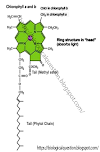Calvin cycle
Introduction :
The Calvin Cycle, also known as the dark reaction or the
light-independent reaction, is a fundamental process of photosynthesis that
takes place in the chloroplasts of plants, algae, and some bacteria. It is
named after its discoverer, Melvin Calvin, who, along with his colleagues,
elucidated the pathway in the 1940s and 1950s.
Photosynthesis is the process by which plants and other organisms convert light energy from the sun into chemical energy in the form of glucose and other organic molecules. The Calvin Cycle is the second stage of photosynthesis, following the light-dependent reactions, which convert light energy into ATP and NADPH.
The Calvin Cycle uses the energy stored in ATP and NADPH to fix carbon dioxide from the atmosphere and convert it into organic molecules such as glucose. It involves a series of enzyme-catalyzed reactions that occur in the stroma of the chloroplasts. The cycle is divided into three stages: carbon fixation, reduction, and regeneration.
Understanding the Calvin Cycle is crucial to our understanding of plant biology, ecology, and agriculture. It is also an essential process for life on Earth, as it produces the organic molecules that sustain all living organisms.
What is Photosynthesis of Calvin cycle ?
The Calvin Cycle, also known as the light-independent reactions, is a series of biochemical reactions that take place in the stroma of chloroplasts in photosynthetic organisms, including plants, algae, and some bacteria. The Calvin Cycle is responsible for converting carbon dioxide (CO2) into glucose (C6H12O6) using energy from ATP and NADPH, which are produced during the light-dependent reactions of photosynthesis.
Steps of Calvin Cycle :
Calvin cycle or C3 cycle can be divided into three main Steps :
Carbon Fixation :
In this first stage, CO2 molecules are added to a five-carbon
sugar called ribulose bisphosphate (RuBP) using the enzyme RuBisCO. This
creates two molecules of a three-carbon compound called 3-phosphoglycerate
(3-PGA).
Reduction :
In this second stage, ATP and NADPH from the light-dependent
reactions are used to convert 3-PGA into a three-carbon sugar called
glyceraldehyde 3-phosphate (G3P). Some of the G3P molecules are used to create
glucose, while others are recycled to regenerate RuBP.
Calvin cycle Diagram
Regeneration of CO2 acceptor :
In this third stage, the remaining G3P molecules are used to
regenerate RuBP, which allows the cycle to continue. This stage requires
additional ATP.
Overall, the Calvin Cycle is essential for the production of
organic molecules that sustain life on Earth. It is also an important tool for
scientists who are studying photosynthesis and trying to develop more efficient
ways to produce biofuels and other renewable energy sources.



.png)

.png)
0 Comments